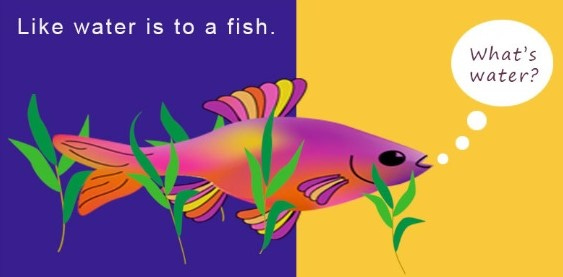My purpose in this book is to begin to explore our culture’s profound illusions. After all, that’s the subtitle of this book! I use the word ‘profound’ because in my observation, there are illusions built into our culture that are so compelling that most of us live our lives inside them and never question whether what we are perceiving is real or is, in fact, illusory. The following parable is designed to illustrate how deceptive and all-encompassing they can be.
The Water-To-The-Fish story
Imagine, if you will, that each of us is a newborn fish. In the few days since we were born, we’ve cautiously swum about some, but now Mom has gathered us together to teach us about our world.
She points out rocks, and that some good things to eat might be found around them. She tells us about the sand, and that there are some creatures that look like sand but might sting us. She lets us know about what’s good to eat and what might want to eat us, and eventually we come to feel as if we have this fish thing wired.
What she doesn’t tell us about, of course, is water, because she doesn’t know about water. She doesn’t know about water because water is all she has ever known. But imagine that one day something happens to you that takes you out of your well-understood reality. In this case, it comes in the form of feeling something sharp and foreign in your mouth. You’re jerked around and pulled upwards, and suddenly you cross some sort of boundary, and you can’t breathe. You’ve been caught! Fortunately for you, you’re in a catch-and-release area and you’re gently put back where you belong. And now you know about the existence of water. You know about water by experiencing what we might call ‘not-water’, so that you can now distinguish water from everything else.
The Water We Swim In
For us humans, the water in this parable doesn’t represent a physical thing. Instead, it takes the form of an explanation of what we see and hear. It is a conventional understanding we have of the world and of our place in it.
However, like the fish in our parable, we look through, and not at, this understanding. It is transparent, like the water the fish swims in. We never think about our idea of the world, and for the most part we’re not even aware that we have one. It’s all we know.
It is pretty strange to think about something that we use every day, that’s so “normal” for us that we don’t give it any thought at all. And yet, the totality of how we look at ourselves, at life, at the world, our entire belief system, is based on this transparent, invisible understanding.
For us humans, this conventional understanding is rooted in one fundamental idea: that the world exists pretty much as we perceive it to be, whether or not we are around to perceive it. It’s a natural, intuitive assumption. We all “know” that when we look at something, we’re seeing it more or less the way it actually is, with or without us.
I put the word “know” in quotes in the previous paragraph because that particular knowing isn’t based on our direct experience. For us humans, it is, in fact, an assumption. Let me offer a way to visualize that idea.
Imagine that you’re wearing a virtual-reality headset, and that it has been in place since you were born. That device generates signals that fool your brain into thinking that the world it creates from those signals is the real world. When things happen in that virtual world which your brain is creating, your body reacts accordingly. And that world is all you have ever known.
Now, someone could come along and explain to you that the virtual world is not the real world, and there would be only one way you could verify that fact for yourself: you’d have to take the headset off.
There is no way to verify that the world, what we think of as reality, exists independently of our perception of it. In order to experience that there’s a world out there that’s independent of our observations, we’d have to look at the world in some other way than observing it through our senses. We’d have to take off the ‘virtual-reality headset’, and we can’t do that.
I’m guessing the preceding paragraph sounds really foreign to you. So, I ask you to bear with me. I’ll explain this hypothesis with as much detail as I can muster throughout the remainder of this book, and after I’ve done so, you can decide whether it’s something worth examining for yourself.
It turns out that there is a completely different interpretation we can make of what we see with our physical eyes.
One day many years ago, I found out about the water I’d been swimming in. I was able to see that the assumption, discussed above, that I’m looking at a world that’s actually “out there,” is just that: an assumption. And that changed everything. It led me to a stunningly new vision of what it is to be a human being. I look forward to explaining how that happened, and we’ll get to that in a few episodes.
In the meantime, I invite you to come along with me and together we can examine our culture and the hidden assumptions that are built into it. I promise it’s worth it!
Next time: the story we all tell about the world that we mistake for the world itself!





interesting, It'll be interesting to see the next explanation!